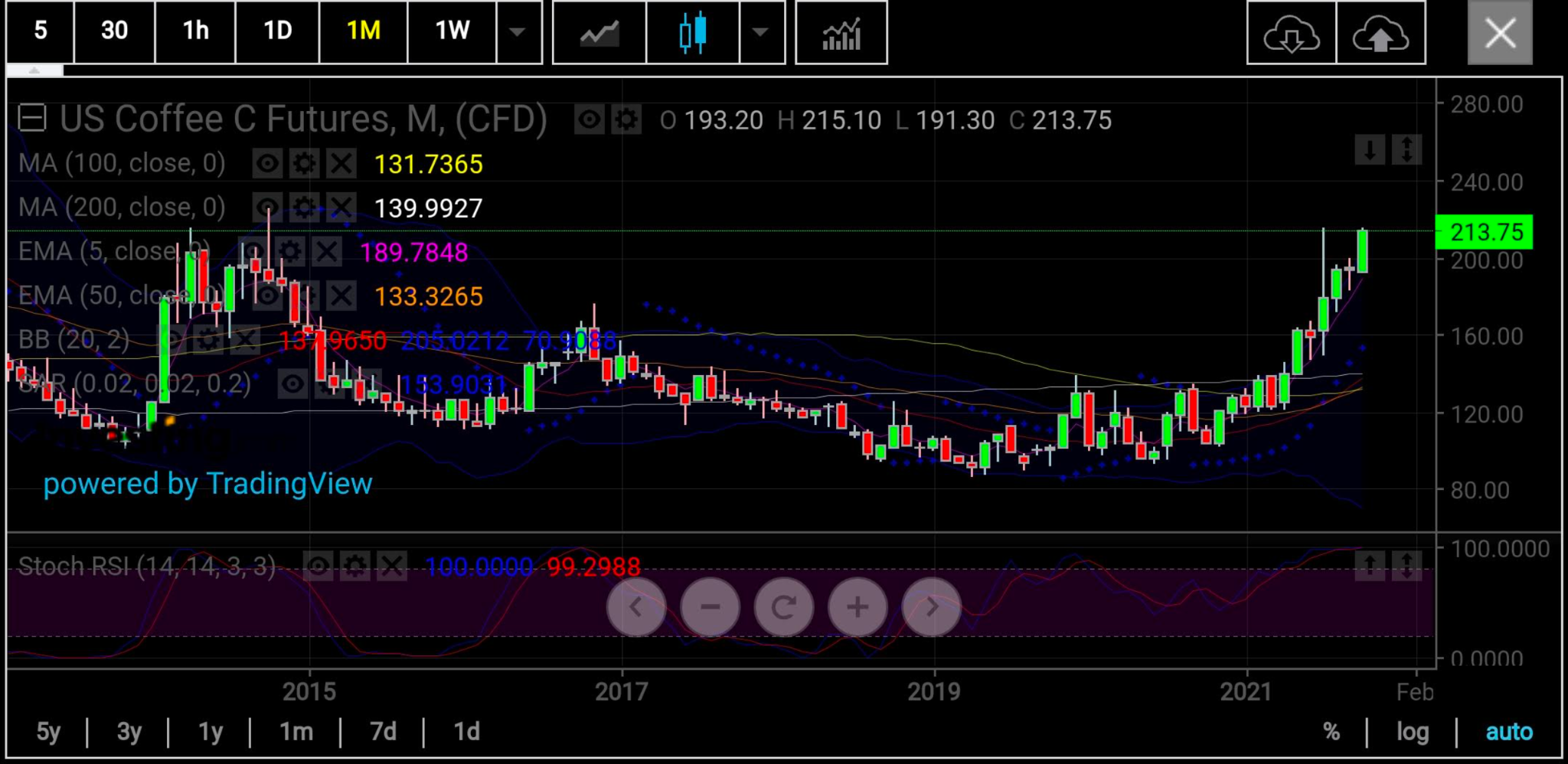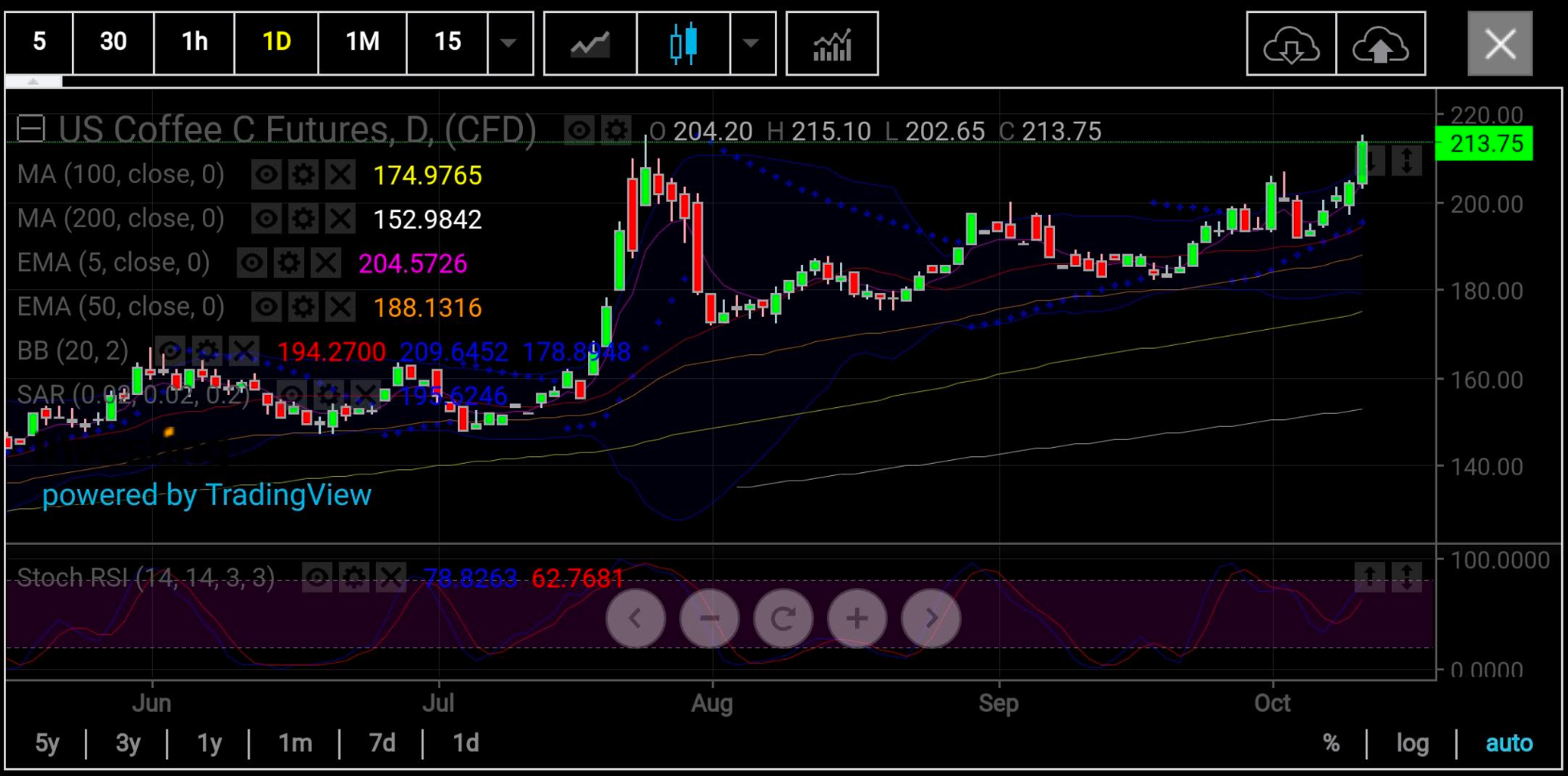Had arabica growers in Brazil been told a year back that their coffee crop would have a bigger rally in 2021 than oil, they’d have probably laughed, then gone back to attending to their fazenda (farm).
Yet, humor or not, that’s exactly what arabica is having: a bigger year than oil.
As of Wednesday, the most-active futures contract of the premium grade coffee was up 66.7% on the year in New York trade, edging US crude oil's front-month contract, which had a year-to-date gain of 65.6%.
It has been a long journey to here for arabica, which hit 15-year lows of 86.35 cents a lb as late as April 2019—though that might seem in distant memory to today’s pricing, which hovers not far from the seven-year high of nearly $2.15 hit in July this year.
Aside from its strong start for October, arabica has rallied in six of the last nine months, after missing out in January, March, and June.

All charts courtesy of skcharting.com
From a thin harvest in Brazil to too much rain in Colombia, the impact of weather gone wrong, along with weak crop yield and supply chain issues from the pandemic, have made it hard for coffee roasters to source prompt, quality, and cost-efficient beans for their customers.
The squeeze has paid dividends for those long the trade as well as arabica growers, who’ve for years been getting pittance for their coffee beans.
But the rallying market is also pinching the world’s top coffee chains—including Starbucks (NASDAQ:SBUX), Costa Coffee and Restaurant Brands International's (NYSE:QSR) Tim Hortons—that rely on arabica and have resisted passing on the higher costs to their customers.
Said Jack Scoville, chief crop analyst at the Price Futures Group brokerage in Chicago:
“The lack of coffee and freight to move the coffee that is available is still supporting futures of arabica. New York, particularly, has found support from the lack of coffee available in Brazil after extreme weather events.”
Weather-wise, Scoville said rains were spotty on any given day and just about all areas get some rain and some get enough over a week or two to promote flowering needed for the crop. “It has been dry in Brazil but there has also been a big freeze there,” he added.
And it’s not just arabica that’s being squeezed.
Robusta, Asia’s favorite coffee largely grown in Vietnam and traded in London, is having about the same crop/logistical challenges. Robusta prices are up 56% on the year.
“London is having trouble sourcing coffee from Vietnam due to a shortage of containers to carry the coffee out of the country and as the country suffers from a resurgence of the Covid epidemic,” Scoville said.
“Wake Up…And Smell It!”
But back to arabica—how strong will this rally remain?

Sunil Kumar Dixit, chief technical strategist at skcharting.com and a regular contributor to Investing.com, says a high of $2.86, or 33% above current levels, is possible if arabica maintains its current trajectory.
“The market has retested the July high of $2.15 despite an extremely overbought reading on the Stochastic Relative Strength Index of the monthly chart,” said Dixit.
“Arabica has been moving up in tandem with the bullish engulfing pattern set by the July candle, which may be affirmed by a follow-up close above that high paving the way for $2.25-$2.35.”
“The pattern, if confirmed, can set long term goals for $2.86 over the long run.”

But Dixit also cautions the possibility of consolidation and sideways-to-down action.
“Breaking below the 5-Day Exponential Moving Average of $2.04 and the 5-week EMA of $2.02 should be seen as initial signs of exhaustion targeting the middle Bollinger[®] Band of $1.94 and the 50-Day EMA of $1.88.”
“The bull charge is, however, a little too potent for this to happen, and we’re likely to see a further break to the upside rather than down. As both the fundamentals and technicals show, this really is arabica’s year. Wake up and smell the coffee!”
Disclaimer: Barani Krishnan uses a range of views outside his own to bring diversity to his analysis of any market. For neutrality, he sometimes presents contrarian views and market variables. He does not hold a position in the commodities and securities he writes about.
